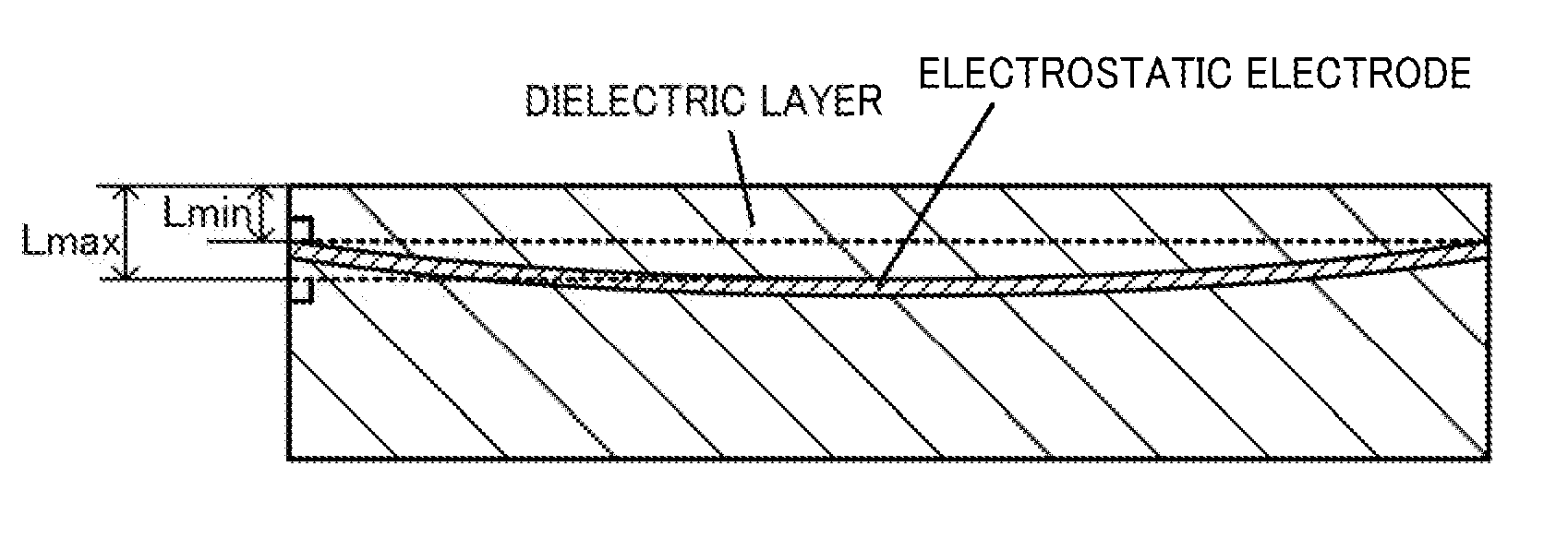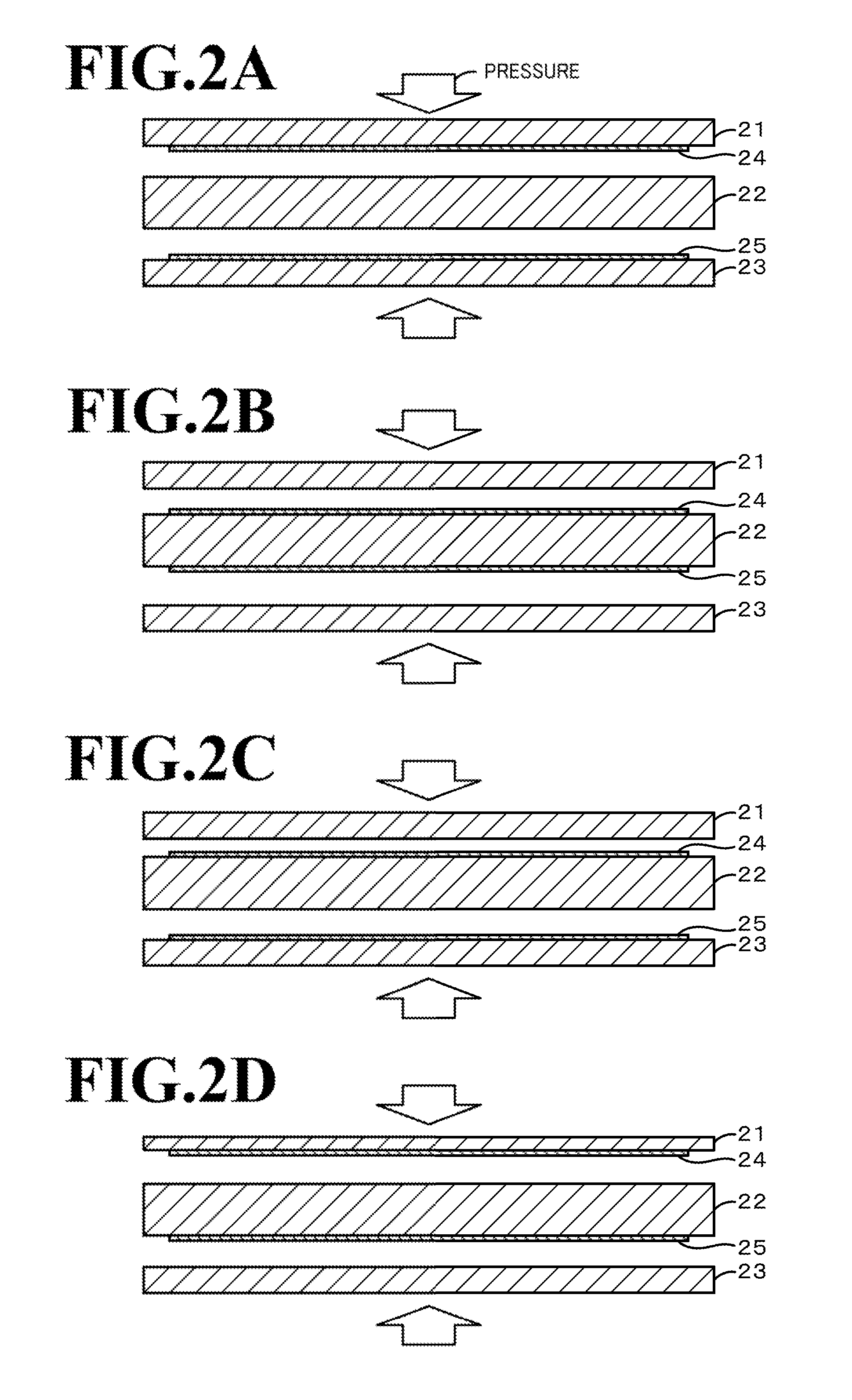Method for producing electrostatic chuck and electrostatic chuck
- Summary
- Abstract
- Description
- Claims
- Application Information
AI Technical Summary
Benefits of technology
Problems solved by technology
Method used
Image
Examples
example 1
1. Preparation of Ceramic Molded Bodies
[0047]A hundred parts by weight of an alumina powder (average particle diameter: 0.50 μm, purity:. 99.7%), 0.04 parts by weight of magnesia, 3 parts by weight of a polycarboxylic acid copolymer serving as a dispersing agent, and 20 parts by weight of a polybasic acid ester serving as a solvent were weighed and mixed in a ball mill (trommel) for 14 hours to prepare a slurry precursor. To the slurry precursor, 3.3 parts by weight of 4,4′-diphenylmethane diisocyanate as an isocyanate, 0.3 parts by weight of ethylene glycol as a polyol, and 0.1 parts by weight of 6-dimethylamino-1-hexanol as a catalyst, each serving as a gelling agent, were added, and the resulting mixture was stirred for 12 minutes by using a rotary and revolutionary stirrer to obtain a ceramic slurry. The ceramic slurry was poured into a first molding die having a disk-shaped inner space 350 mm in diameter and 4.0 mm in height, a second molding die having a disk-shaped inner spac...
example 2
[0051]In section 3. of Example 1, screen-printing was not conducted on the first and third ceramic calcined bodies but the electrode paste was screen-printed on one surface of the second ceramic calcined body to form an electrostatic electrode and on the other surface of the second ceramic calcined body to form a heater electrode. In section 4. of Example 1, as shown in FIG. 2B, the first to third ceramic calcined bodies were superposed and subjected to hot-press firing to form a sintered body. Subsequently, side processing and hole drilling were conducted and terminals were attached to obtain an electrostatic chuck having built-in electrostatic electrode and heater electrode. The conditions for the hot-press firing were the same as those in Example 1. The resulting electrostatic chuck had a carbon content of 0.1 wt % or less and a relative density of 98% or more. The variation in the thickness of the dielectric layer was 55 μm.
example 3
1. Preparation of Ceramic Molded Bodies
[0052]A hundred parts by weight of an aluminum nitride powder (average particle diameter: 0.5 μm, purity: 99.7%), 3 parts by weight of europium oxide, 8.7 parts by weight of alumina, 0.4 parts by weight of titanium oxide, 3 parts by weight of a polycarboxylic acid copolymer serving as a dispersing agent, and 25 parts by weight of a polybasic acid ester serving as a solvent were weighed and mixed in a ball mill (trommel) for 14 hours to prepare a slurry precursor. To the slurry precursor, 7.7 parts by weight of 4,4′-diphenylmethane diisocyanate as an isocyanate, 1.4 parts by weight of ethylene glycol as a polyol, and 0.3 parts by weight of 6-dimethylamino-1-hexanol as a catalyst, each serving as a gelling agent, were added, and the resulting mixture was stirred for 10 minutes by using a blade stirrer to obtain a ceramic slurry. The ceramic slurry was poured into a first molding die having a disk-shaped inner space 350 mm in diameter and 4.0 mm i...
PUM
| Property | Measurement | Unit |
|---|---|---|
| Grain size | aaaaa | aaaaa |
| Temperature | aaaaa | aaaaa |
| Temperature | aaaaa | aaaaa |
Abstract
Description
Claims
Application Information
 Login to View More
Login to View More - R&D
- Intellectual Property
- Life Sciences
- Materials
- Tech Scout
- Unparalleled Data Quality
- Higher Quality Content
- 60% Fewer Hallucinations
Browse by: Latest US Patents, China's latest patents, Technical Efficacy Thesaurus, Application Domain, Technology Topic, Popular Technical Reports.
© 2025 PatSnap. All rights reserved.Legal|Privacy policy|Modern Slavery Act Transparency Statement|Sitemap|About US| Contact US: help@patsnap.com



